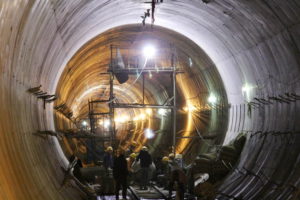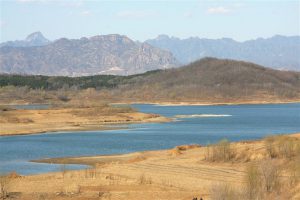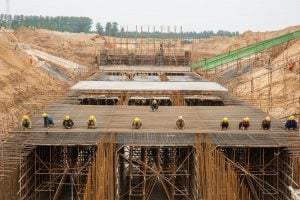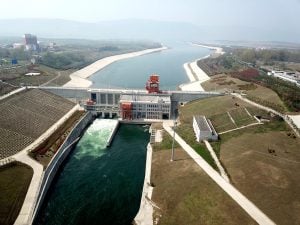China’s mega water projects, such as the Three Gorges Dam and the South-to-North Water Diversion project (SNWD), are famous.
There is a sense in some quarters that the country is shifting from an emphasis on “hard” water infrastructure to more “soft” regulatory policy, and perhaps also from a focus on safety (flood prevention) and supply to projects that emphasise ecological improvement such as pollution control and urban greening. Whilst there is no doubt that China’s water policy and regulation is becoming more sophisticated, we argue that China’s water infrastructure construction has continued to accelerate, and that ecological improvement plays only a modest part in this growth.
Nevertheless, there are important changes in the character of that construction. What we are witnessing is a new phase of Chinese water management in which a national “water grid” is being developed, fed by inter-basin transfers, and in which the existing water network is being elaborated.
A new type of infrastructure boom
Far from signalling the end of major water infrastructure projects, the completion of the eastern and middle routes of the SNWD in 2014 coincided with an announcement by the State Council of 172 major new water infrastructure projects. By the end of 2019, 142 of these had commenced construction, with 17 of the remaining 30 projects shifted to a second round. That second round of 150 projects was announced in 2020 by the State Council, in part as a response to the floods of summer 2020. The Guiding Opinions on the Implementation of Major National Network Projects released in January 2022 point to the Chinese government’s plans to further expand water investment during the 14th Five-Year Plan period (2021-2025).
What we are witnessing is a new phase of Chinese water management in which a national “water grid” is being developed
Information about the “172 + 150” projects has to be pieced together from official websites of government agencies at different levels. We found that the projects include new dams, diversions and pumping stations to increase supply, control floods, raise irrigation supply and efficiency, and move water between regions. They also include large ecological improvement projects. If completed, the 172 + 150 projects will increase the quantity of water available for use nationally by 122 billion m3 annually (which is about a 20% increase), save 26 billion m3 of irrigation water annually, increase flood control storage capacity by 31.6 billion m3 (for comparison, this is equivalent to about half of the annual flow in the Yellow River) and increase China’s irrigated area by about 10% (107 million mu). The total estimated investment will be 2.99 trillion yuan (US$470 billion).
On paper, there are four main types of infrastructure projects: inter-basin water diversion projects (36% of expenditure); water source projects, in which large dams or pumping stations are built to increase local water supply (13%); enhancement of flood control capacity in dams and lakes (36%); and new irrigation systems (15%). In reality, there is some overlap in these figures, where projects have multiple uses, such as dams for both flood control and water supply. Forty percent of the investment in these projects goes toward water for household and industrial use, another 20% for irrigation, and only 1% for ecological restoration (the remainder is primarily for flood control).
Between 2008 and 2019 there was a spectacular seven-fold increase in annual expenditure on water infrastructure projects. The major boost in investment began with the 172 + 150 projects after 2014. In 2001, flood control was the largest construction category, with 55% of investment, but this had fallen to 34% by 2019, although it still constitutes the largest number of projects. Investment in hydropower projects has also declined slightly. Projects aimed at increasing supply (predominantly dams and inter-basin transfers) have consistently grown in importance over time, becoming the most important category after 2007 (about 50% of investment in 2015). The volume of water allocated to “ecological water” (supplied to rivers, lakes and wetlands, and for landscaping and environmental sanitation) has doubled from 10 billion m3 to 20 billion m3 since 2014, but this still only makes up about 3% of total water use. The enormous increase in water available for use from these two rounds of projects is equal to four times the capacity of the SNWD’s middle route.
A multi-layered grid
There are three distinctions between the two rounds of projects. The first is in geographical focus. The main focus of the first round of projects was in the Yangtze, Songhua and Liao River basins, expanding the water grid’s main skeleton. While the second round of projects focused more on flood management, irrigation supply and environmental flows in the Yellow River. The focus on the Yellow River is in line with the 14th Five Year Plan, which pays renewed attention to so-called high quality development proposals for the Yellow River.
The second distinction is an increase in the number of ecological water projects, suggesting that environmental flows are being given heightened priority in the 14th Five Year Plan period (2021-2025). The third is the idea of “smart” water projects, which are a new category introduced in the second round. There are five such projects in which hydrology and water resource information will be carefully monitored and digitalised in an attempt to micro-manage the whole hydraulic infrastructure system. Even so, the largest number of projects retain the traditional goals of flood control, water diversion and irrigation supply.
Despite these differences, the SNWD and the 172 + 150 projects have common justifications: that water resources are unevenly distributed in China and that water is not located where development has occurred or should occur. The volume of water shifted by inter-basin transfer projects has steadily increased, reaching 48.5 billion m3 per year by 2016 (equivalent to ~8% of national water use). Nearly 40% of the investment in the 172 projects consists of 16 major inter-basin transfers, distributed all over the country.
In terms of governance, the current plan is to assign each of the four main layers of China’s administrative hierarchy to perform specific duties. The central government is responsible for the “main skeleton” of the system: in addition to the “three verticals, four horizontals” of the SNWD (the three south-to-north planned routes of the SNWD linking four west-to-east flowing rivers), it will also be responsible for new water transfer projects, including the Han River to the Wei River, the Yangtze River to the Huai River basin, canals from the SNWD to Xiong’an, and drinking water supply reservoirs in Inner Mongolia and the Beibu Gulf. Provincial governments will be responsible for linking their major hydraulic infrastructure within the provinces to this national main skeleton. Municipal- and county-level governments will be expected to focus on linking irrigation areas and local urban water systems to the main provincial networks.
Water security redefined?
The nature of this emerging network brings into question water scarcity and geographic imbalance as defining features of China’s water profile. The development of a national water grid elaborates the existing water infrastructure system to coordinate the use of existing dams and river systems – often by diverting that water to neighbouring basins. The emergence of this water ‘skeleton’ already challenges notions of regional natural water availability: cities in the north are now drawing on multiple sources of water, some from very far away. At regular intervals, we hear of impending regional water (and by extension, geopolitical) crisis in China; if it works, the water network will render these scenarios increasingly unlikely.
The 12th and 13th Five Year Plans strongly emphasised improved water quality and improved general amenity. The result has been some redirection of water for ecological purposes, reflected in the plans to develop Xiong’an, outside Beijing, with extensive urban water area requiring over 500 million m3 of transferred water annually. As noted above, investment in ecological water has increased, but the amount of water used for this purpose is still small. Thus, it is too early to argue that environmental purposes now dominate Chinese water investment; nevertheless, this does point to a fundamental shift in priorities. The greening of urban space and improvements in water quality in river channels will be used as key indicators for evaluating China’s water security. This does not appear to be a “quick fix”, merely flushing polluted river channels and lakes; rather, the aim is to improve water quality from Class V (not for any use) to Class III (minimum drinkable standard).
While mega infrastructure projects like the Three Gorges Dam and the SNWD have long been in the headlines, China has been quietly moving towards a highly integrated water supply network that has massively increased the water available for cities and irrigators and is allowing the government to monitor and to some extent control how water flows at the national scale all the way through to the level of counties. The completion of mega water projects has not signalled the end of infrastructure construction. Instead, the pace of water construction has rapidly increased, especially with the 172 + 150 projects post-2014.
Such a national water supply network represents a continuation of some past emphases, such as the focus on concrete-heavy infrastructure, but also represents a shift in ambition and a new attention to environmental concerns. Increasingly, such a network will consolidate control over water supply at the national level and allow the Chinese state to move water around at an unprecedented scale.
Acknowledgements: the authors would like to acknowledge the broader project team that includes Michael Webber, Ian Rutherfurd, Mark Wang, Zhao Yue, Shi Chenchen, Zhen Nahui, Jon Barnett, and Han Xiao.








